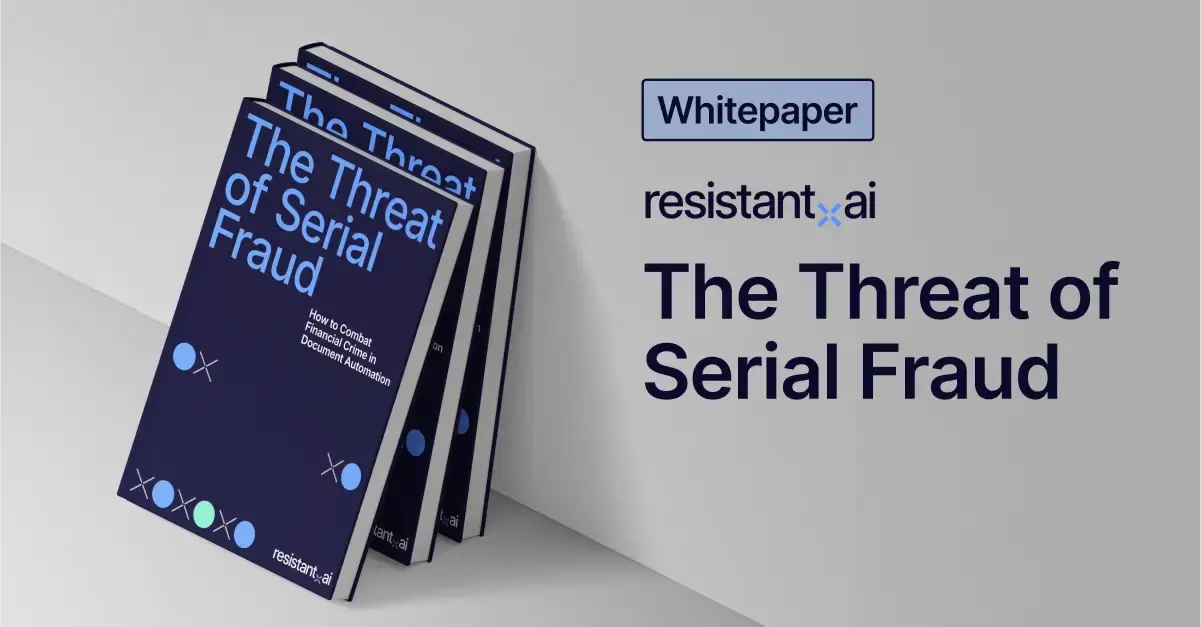
You might be interested in










As global trade volumes rise and customs processes continue to shift online, fake export declaration risks are rising in 2025. China has already begun taking action. They introduced new export-compliance rules at the beginning of this year, banning the use of third-party documents to declare goods at customs. Surely these regulations will be accompanied by increased scrutiny of such documents, and your business should do the same.
These documents play a central role in verifying shipments for trade finance, sanctions screening, and cross-border logistics, which means even a single forged declaration can distort risk decisions, inflate payouts, or mask illicit exports.
At the same time, generative AI tools, freely available document fraud templates, and easy-to-use PDF editors have made it simpler than ever for fraudsters to fabricate export paperwork that appears authentic.
Banks, freight forwarders, manufacturers, and compliance teams now face a surge of export declaration fraud designed to slip through manual review.
To protect your business, it’s essential to understand what export declarations contain, how forgers manipulate them, and the signs that indicate something isn’t right.
Read on to learn what export declarations are, how they’re being forged, how to spot a fake, and how AI-powered tools can help verify them automatically.
Check out our “how to spot fake documents” blog to learn about more common document forgeries.
An export declaration is a formal submission to a national customs authority that:
These documents are generated through regulated customs platforms that enforce fixed schemas and mandatory data fields. Common systems include AES (Automated Export System) in the EU, AESDirect and ACE (Automated Commercial Environment) in the United States, CDS (Customs Declaration Service) in the United Kingdom, CERS in Canada, and ICS in Australia.
Although the printable layout can differ between countries, real export declarations almost always include core elements that follow internationally recognized rules, making export declarations reliably verifiable across different jurisdictions.
These standardized components typically found in an export declaration include:
These documents are used to confirm/verify the legal export of goods, the identity of the trading parties, and the compliance status of the shipment.
.png?width=1033&height=1337&name=export%20declaration%20demo%20doc%20(1).png)
An example of an export declaration for illustrative purposes only
Export declarations play a crucial role in international trade because they verify: what is being shipped, who is shipping it, and whether the movement complies with customs, sanctions, and export control rules.
Many industries rely on them as foundational evidence of shipment legitimacy, value accuracy, and cross-border compliance.
Here’s how export declarations are used for document verification across specific industries:
Because export declarations come directly from customs systems and follow standardized data rules, they are widely trusted as proof that a shipment is legitimate and compliant.
If you’d like to know how fraudsters are creating all these fake export declarations, check out our “Types of fraud” blog to learn more about their tactics.
Spotting a fake export declaration manually requires deep familiarity with how real customs documents are structured.
Fraudsters often rely on template packs, recycled paperwork, or AI-generated layouts that look indistinguishable to the naked eye.
At scale, these fakes can distort trade finance decisions, mask illicit shipments, or create false evidence for cross-border transactions. The only way to deal with them en masse is an AI document fraud detection software.
Still, if you’re trying to verify export declarations manually, here’s what to watch for:
Real export declarations follow regulated schema logic generated by customs systems. If your document doesn’t match these templates, something is usually wrong.
Many fakes rely on mixing real trade data with fabricated or incompatible details.
Fraudsters often miscalculate or misunderstand the financial and logistical fields required.
Internal contradictions often reveal that different parts of the document were edited or stitched together.
Sometimes the most tell-tale signs of fraud are hidden within the document’s metadata.
Disclaimer: Fraudsters now rely heavily on AI tools and high-quality template replicas to generate export declarations that look authentic even up close. Because manual inspection cannot reliably detect structural tampering, subtle inconsistencies, or synthetic document patterns, organizations increasingly require scalable AI document verification to stay ahead of modern export declaration fraud.
Export declarations are commonly reviewed by trade finance teams, freight forwarders, customs brokers, sanctions and compliance analysts, and internal logistics departments manually or using automated systems, but the reliability of each approach varies significantly.
Manual verification is becoming increasingly difficult to rely on because modern fraud tools allow criminals to modify data fields, recycle old declarations, and generate convincing AI-produced replicas that mimic customs layouts. Human reviewers often struggle to identify subtle inconsistencies in HS codes, routing data, or MRN/ITN formats, especially when volumes are high or when documents come from multiple jurisdictions.
AI-powered automation offers a more scalable and consistent alternative. Advanced systems can detect structural anomalies, verify code logic, analyze metadata patterns, and flag subtle irregularities that are almost impossible to identify visually. Automation also accelerates verification workflows by analyzing documents in seconds rather than minutes.
Still, many organizations continue using manual review because of legacy processes, regulatory expectations, or cross-department workflows that were designed before AI-based tools were widely available. If manual checks are part of your process, here are specific actions that help improve accuracy.
If you’re still manually reviewing export declarations, start with the 5 signs we mentioned above. Then you can try some of the sources below:
Keep in mind: Manual review cannot reliably detect structural manipulation, synthetic document creation, or coordinated fraud patterns across multiple submissions. As volumes grow and fraud techniques evolve, manual verification alone cannot scale to meet real-world risk levels.
AI plays a critical role in identifying fake export declarations because it can analyze structural, behavioral, and metadata signals that human reviewers do not see. Rather than reading or storing the document’s content, advanced AI models examine how the file was built, which systems created it, and whether its internal patterns match what genuine customs platforms typically produce.
Here are the key benefits of AI in spotting export declaration fraud:
Basic automation can perform useful rule-based checks, such as confirming whether an MRN field is filled, a barcode is present, or a required section exists. However, automation cannot understand whether an MRN follows the correct format for the jurisdiction, whether an HS code matches the described goods, or whether the document structure aligns with real customs output. Its accuracy is limited by predefined rules and templates.
AI, on the other hand, learns from evolving fraud patterns and adapts to new document types, editing techniques, and generative AI outputs. It examines the full structure and behavior of the file, not just the visible fields, and can detect subtle manipulation patterns (including GenAI-generated artifacts) that automation and human reviewers routinely miss. Resistant AI also uses specialized layout models, generative AI detectors, and cross-document intelligence to uncover complex, multi-submission export fraud that traditional approaches cannot see.
Fake export declarations hide illicit shipments, distort trade finance decisions, and undermine compliance across international supply chains.
Resistant Documents offers a faster and more reliable alternative, analyzing the deep structure of export declarations forensically to detect hidden anomalies in layout, metadata, context, image consistency, and hundreds of other indicators across multiple submissions.
Reduce manual effort and stay ahead of increasingly well-made export fraud. Scroll down to book a demo.
Hungry for more fake export declaration content? Here are some of the most frequently asked fake export declaration questions from around the web.
You can verify a declaration by confirming the MRN or ITN through the appropriate customs portal, automated tools, AI, or the 5 red flags we mentioned above.
Yes, but only partially. Some jurisdictions allow MRN validation through customs tracking portals, while others require access through registered brokers or exporters. Online verification is usually limited to reference number checks, not full document authenticity.
Yes. Fraudsters frequently use fabricated export declarations to support inflated invoices, create phantom shipments, or justify financing for goods that never existed. This makes them a known risk in trade finance and supply chain verification.
AI detects fake export declarations by analyzing structural patterns, metadata traces, and submission logic rather than reading sensitive content. By examining how the file was created, which systems generated it, and whether its internal components match real customs output, AI can flag risks far more accurately than manual review.
Export declarations, bills of lading, and commercial invoices each document a separate stage of cross-border trade: the export declaration reports shipment data to customs, the bill of lading records the carrier’s receipt and transport of the goods, and the commercial invoice details the sale and pricing of the shipment.
Export declaration. Records shipment data, HS codes, exporter details, customs procedure codes, and MRN/ITN references.
Bill of lading. Serves as a contract of carriage, a receipt for goods, and sometimes a document of title.
Commercial invoice. Lists the goods, quantities, prices, INCOTERMS, and payment details.
Yes. Resistant AI provides document-agnostic, structural analysis that identifies manipulated export declarations, detects reused templates, and flags anomalies invisible to human reviewers. It does this without relying on databases or reading sensitive content, preserving privacy while improving accuracy.
Several roles are directly responsible for verifying export declarations and ensuring that shipments, values, and classifications are legitimate:
Yes. Creating, altering, or submitting a fake export declaration is illegal in nearly every jurisdiction. In the United States, fraudulent filings can trigger penalties under federal customs laws and export control regulations. In the EU and UK, submitting falsified declarations can lead to fines, cargo seizures, criminal charges, or export-license suspension. Penalties escalate significantly when the fraud involves sanctions evasion, dual-use goods, or financial gain.


